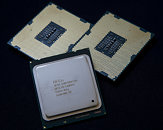Tuesday, March 24th 2015

Intel to Launch Just Two LGA1150 "Broadwell" Parts
In what could be a sign of Intel being stuck with "undigested" Core "Haswell" inventories, BGA chips becoming commonplace for desktop platforms that don't see CPU upgrades, or even "Broadwell" being too short a stopgap between "Haswell" and "Skylake," the company has reportedly decided to launch just two socket LGA1150 Core "Broadwell" parts, when the silicon hits the market towards June.
Built in the 14 nm silicon fab process, "Broadwell" will bring about performance/Watt increments, and Intel doesn't appear to be in the mood to trade those in for higher clock speeds (higher performance out of the box). It's relevant to note here, that the "Broadwell" core is essentially an optical shrink of the "Haswell" CPU architecture to 14 nm, much like "Ivy Bridge" was to "Sandy Bridge," even if the silicon seating the cores itself is much different (meatier iGPU). Intel will be going in with just two parts, both of which are unlocked, for PC enthusiasts to chew on. These include the Core i7-5775C and the Core i5-5675C.Both the i7-5775C and the i5-5675C are quad-core parts, with TDP rated as low as 65W. The i7-5775C offers clock speeds of 3.30 GHz, with 3.70 GHz Turbo Boost, while the i5-5675C offers 3.10 GHz, with 3.60 GHz Turbo Boost. The i7-5775C comes with just 6 MB of L3 cache, while the i5-5675C offers just 4 MB of it. The i7-5775C offers HyperThreading, letting the OS address eight logical CPUs, while the i5-5675C lacks it. Both chips feature Intel's Iris Pro 6200 series integrated graphics, and feature dual-channel DDR3L-1600 memory support. It will be interesting to see how the two compare to the existing i7-4790K and i5-4690K, although something tells us that they're not comparable. The two will be compatible with existing LGA1150 motherboards, with BIOS updates.
Source:
VR-Zone
Built in the 14 nm silicon fab process, "Broadwell" will bring about performance/Watt increments, and Intel doesn't appear to be in the mood to trade those in for higher clock speeds (higher performance out of the box). It's relevant to note here, that the "Broadwell" core is essentially an optical shrink of the "Haswell" CPU architecture to 14 nm, much like "Ivy Bridge" was to "Sandy Bridge," even if the silicon seating the cores itself is much different (meatier iGPU). Intel will be going in with just two parts, both of which are unlocked, for PC enthusiasts to chew on. These include the Core i7-5775C and the Core i5-5675C.Both the i7-5775C and the i5-5675C are quad-core parts, with TDP rated as low as 65W. The i7-5775C offers clock speeds of 3.30 GHz, with 3.70 GHz Turbo Boost, while the i5-5675C offers 3.10 GHz, with 3.60 GHz Turbo Boost. The i7-5775C comes with just 6 MB of L3 cache, while the i5-5675C offers just 4 MB of it. The i7-5775C offers HyperThreading, letting the OS address eight logical CPUs, while the i5-5675C lacks it. Both chips feature Intel's Iris Pro 6200 series integrated graphics, and feature dual-channel DDR3L-1600 memory support. It will be interesting to see how the two compare to the existing i7-4790K and i5-4690K, although something tells us that they're not comparable. The two will be compatible with existing LGA1150 motherboards, with BIOS updates.

53 Comments on Intel to Launch Just Two LGA1150 "Broadwell" Parts
i thinks is not gona happen....
There is not a single DDR4 IMC that supports higher then 2133 natively (Only choice we have for DDR4 is Haswell E anyways). So anything above that is not really standard. Its still an overclock in respect to what the IMC allows.
By the time DDR4 was even widely available on the consumer market, we had people taking DDR3 DIMMs to 3000mhz+Not necessarily, especially if people need the actual cores in the i5/i7s for applications other than gaming. Not to mention, with DX12 on the horizon, multi-threading for games should be better so more cores might actually make a difference in games for once.